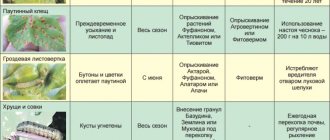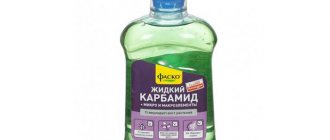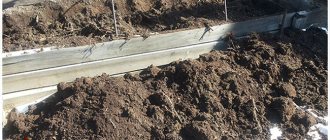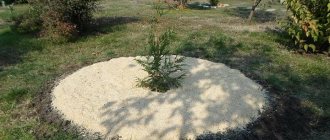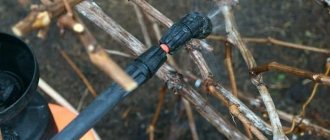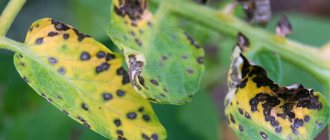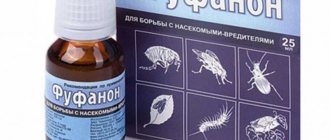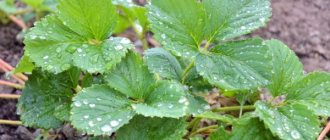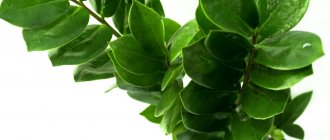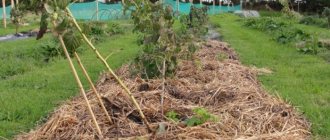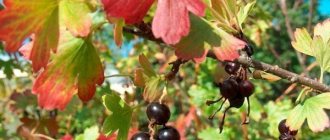Raspberries are one of the most common berries in Russia. Tasty, sweet, extremely healthy. During the summer season, you want to eat plenty of aromatic berries, feed them to your children and grandchildren, and make compotes and jam for the winter. To realize the entire wish list, you will need a lot of raspberries, so increasing the yield and maintaining the quality of the fruits should be given increased attention. Pests and diseases of raspberries can negate all the gardener’s efforts to grow raspberries. Before writing the article, we read a large number of notes on processing raspberries in the spring. However, the lion's share of the material contained general information related to spring pruning of bushes, feeding them, mulching the soil, etc. There were very few specific clear instructions specifically for spring treatment against diseases and pests. We will try to fill this gap, approach the problem in a structured manner and describe all options for protecting raspberries using both chemical and folk remedies.
Spring processing of raspberries: why is it necessary?
So that the bushes do not get sick and bear a lot of berries, in the spring they are treated, both physical (elimination of frozen shoots) and chemical. Failure to spray with chemicals will lead to the rapid development of a colony of parasites and the death of the bush, or even part of the plantation.
Did you know? A hectare of wild forest raspberries can produce up to 70 kg of honey per season. Industrial and garden plantations can produce only 50 kg of this product.
Various types of pests eat leaves, drink juice from shoots and destroy even woody stems. In case of diseases, the plant can independently stop the development of diseased branches and direct its forces to the growth of new shoots.
But he needs help to cope with his illness. All these problems are eliminated by spring treatment of bushes. In this case, the berries will be whole, of the correct shape, rich in color and taste.
What pests threaten raspberries?
To protect raspberries from insect pests, it is recommended to study the descriptions of the most common ones. These include the raspberry beetle, weevil and glass beetle.
Raspberry beetle
The size of the insect does not exceed 6 mm, the color is gray-brown. The raspberry beetle, or raspberry beetle, multiplies quickly; its offspring can destroy the entire crop .
The pest appears at the end of April or at the beginning of May, when the soil warms up to +12°C . First, the raspberry beetle eats the leaves, then proceeds to shoots and young fruits. If the beetle is not destroyed, it burrows into the ground at the end of summer and pupates, only to reappear the following year.
Important! Raspberries love pears, plums, and apples and can get onto bushes from these crops.
Raspberry glass
Caterpillars overwinter inside damaged shoots, then gnaw passages in the roots and stems . The body of the glass moth is thin; adult butterflies are colored black and blue. In the caterpillar stage, the insect is white, the head is brown or orange.
If the raspberry glass is not detected in a timely manner, the bushes dry out, the branches become weak and take on a sickly appearance. If it is possible to see signs of damage, then weak shoots are removed and burned away from the garden plot. The remaining bush is sprayed with systemic fungicides.
Weevils
The beetle is easy to recognize by its gray-black color and elongated proboscis. The weevil becomes active in the spring, when the air temperature warms up to +14°C .
Insects lay eggs in the buds, causing them to turn brown . Because of this, raspberry yields are reduced by 40-70%. Weevils appear especially often in old areas where raspberry bushes have not been pruned and formed for a long time.
Interesting things on the site:
Which raspberry varieties are the most productive?
Advantages and features of early raspberry varieties
Preparation of tools
Before spraying, it is necessary to prepare the bush for this. Using a sharp knife or pruning shears, cut off the frozen tops of shoots and branches that thicken the plant, and rake last year's leaves from the root zone.
All instruments must be clean and sharpened - the smoother the cut, the less chance of disease. Before use, it is advisable to disinfect instruments with a weak solution of potassium permanganate or alcohol.
Diseases and pests of shrubs
Treatment of honeysuckle in spring against diseases and pests
Raspberries are susceptible to diseases that also affect other garden plants. Some of them are associated with errors in care, others are fungal, bacterial, or viral in nature. Insects do not bypass the shrub; they feast first on the stems, then on the buds, leaves, and gnaw out the buds. If the necessary measures are not taken, they will get to the fruits.
Raspberry diseases
The infection can enter the area with new seedlings that have appeared in the garden, invading pests, or carried in by the wind. If currants grow next to raspberries, the bushes begin to hurt at the same time.
Raspberries and currants
Ordinary raspberry varieties are weakly resistant to infections. The remontant species and new hybrids have greater immunity, but if you don’t spray them in the spring or stop caring for them, then these varieties will quickly get sick.
Main diseases of raspberries
| Infection | Short description |
| Viral diseases | |
| Mosaic | Light, sharply defined marks form on the leaves, gradually merging into rings. During the process, the plates turn pale, then turn yellow and become covered with necrotic spots. If the virus appears at the time of flowering, you can see streak-like, elongated, small spots on the petals that differ in shade |
| Chlorosis | Pests, penetrating into breaks and cuts on the stems, infect the plant with a virus, causing the shoots to turn yellow and thin. The whole bush gradually dries out |
| Curly | This disease affects the plant slowly - over 2-3 years. The leaves become smaller, wrinkled, and become tough. The plate below becomes brown. The bush becomes deformed and gradually dries out. Berries lose their taste value |
| Bacterial | |
| Septoria | The leaves become covered with brownish-purple spots, which subsequently turn grey. In this case, the edges are lighter than the core, on which you can see tiny black dots |
| Rot is wet | The leaves begin to turn yellow from the tips, then the entire leaf changes color. Then dark gray or brownish wet spots appear. Very quickly the infection spreads to the stems, penetrating into the core. If the flowers have time to bloom, they fall off. The disease is characterized by a strong, unpleasant odor |
| Cancer | The disease creeps up unnoticed, so it is difficult to understand when the kidneys die. The problem is indicated at the moment of budding - too few flowers are formed. Even those that have managed to open quickly turn black and dry out. You can also notice cancerous growths on the shoots |
| Fungal diseases | |
| Gray rot | The leaves turn yellow completely, and black small dry spots appear on the underside of the plate. The shoots are covered with a fluffy ash-gray coating, which can be seen later on the fruits |
| spotting | First, gray, brown or black spots appear on the leaves. Sometimes they have a border or are dotted with small dots. Gradually the leaves turn yellow, die and fall off. The bush is delayed in development and loses its decorative effect. Most often the disease is associated with poor nutrition |
| Rust | Yellowish spots on the leaves begin to darken, becoming like metallic rust. Yellow dusty pads form on the underside of the plate, which turn into black stripes by the end of the season. |
| Anthracnose | The onset of the disease is characterized by dark red or grayish-purple round spots covering the leaves and stems. Along the contour you can see a spotted edging. Leaf tissue captured by spores becomes fragile and may fall out. The stems become ulcerated with wounds, then turn brown and dry out. |
| Powdery mildew | On the shoots and leaves you can notice a powdery coating in the form of a cobweb. The mycelium grows, forming small balls that darken over time. Tissues affected by plaque turn yellow, dry out, and leaves fall off |
Important! If you do not notice the development of diseases in time and do not take the necessary measures, you can not only lose most of the harvest, but also destroy the entire plantation.
Pests
Most insects are very small and difficult to immediately detect on raspberries. Many pests live in the soil, eating up the roots, or settle inside the shoots, buds and penetrate the berries. Therefore, it is very problematic to fight them without knowing the main signs of the invasion.
Raspberry pests
| Name | Signs |
| Stem gall midge | The appearance of an insect that has penetrated inside the stems can be judged by the ugly swellings that appear on the shoots |
| Weevil | With its long proboscis, the pest pierces the plant tissue and sucks out the juices. Exhausted shoots wither and leaves fall off. If the weevil gets to the berries, they dry out |
| Crimson beetle | It feeds on leaves, flowers and berries. The fruits quickly deteriorate and become smaller |
| Spider mite | Its presence can be recognized by the white punctures that appear on the leaves. If the bush is significantly affected, it quickly withers and dies |
| Stem fly | The insect sucks juices from the shoots, causing the tops of the stems to wither and droop |
| Raspberry nutcracker | Pests feed on shoots, causing them to crack. 10-centimeter swellings can be seen on the stems at the site of tissue damage |
| Aphid | These small green insects are immediately visible - they cling to the stems and leaves in entire colonies. They also penetrate into buds that have not yet opened. |
When to treat for pests and diseases. Despite its small size, pests very quickly attack raspberries. If you do not take preventive measures and do not fight them, the berry plant will begin to get sick and lose its quality. In some cases, the affected bushes will even have to be removed so that they do not infect other crops in the garden.
The main preventive measures are carried out in early spring, treating the bushes with special preparations. It is necessary to spray the raspberry tree several times throughout the season at intervals of 2-3 weeks, since each pest has its own period of activity.
Chemicals can be used until budding begins. As soon as there is abundant color, use exclusively harmless folk remedies. It is necessary to treat not only the bush, but also the soil around it.
Raspberry blossom
At the same time (from March until the buds swell), poorly overwintered shoots should be cut off: frozen, diseased, damaged.
Note! Along with preventive treatment of the berry garden, feeding is carried out. Fertilizers contain substances that can neutralize insect larvae and prevent fungal spores from multiplying.
What to process?
Processing is carried out using various means, both industrially manufactured and those produced according to folk recipes.
Biological substances
Environmentally friendly biological products will not harm the environment. They contain active bacteria, antagonistic fungi and viruses that are not capable of harming the plant. But they can destroy pathogenic infections and pests.
Important! In addition to the medicinal effect, biological preparations act as fertilizer for berry bushes.
The main biological drugs are as follows:
- "Bitoxibacillin." Used to kill raspberry mite larvae on leaves and stems. Has an internal effect on the intestinal system of the pest.
- "Bisolfibit". Not really a cure, more of a healthy growth stimulant. This product is based on a dry mixture of fertilizers of biological origin. After application, the already strong plant will resist disease.
- "Fitoverm". The substance is made from waste products of microorganisms living in the soil. Within a few hours after use, you can observe the results - the diseased plant will begin to revive. The effect of the drug lasts up to three weeks, after which the treatment must be repeated.
It is better to place biological substances in the root soil in a dry form - they are well washed away by irrigation water and rain and have a maximum range of action.
Chemical substances
This type of treatment product contains toxic components that will certainly destroy pests and the source of the disease, but are not always gentle on the plant itself. Chemicals are the next step after the use of milder biological drugs, if they do not give the desired effect.
Read more about why raspberry leaves turn yellow.
The most common chemicals are as follows:
- Iron and copper sulfate . Destroy all types of fungi and bacteria. The crystalline salt of these chemicals is diluted with water to a 5% solution and the bushes are sprayed with it.
- "Cuprozan". The product contains copper, which helps fight leaf spot. 1–2 times during the spring-summer season it is necessary to spray a 4% solution on the foliage.
- Phthalan (Bordeaux mixture). Resists any fungal diseases. It is enough to dissolve 40 g of the product in a liter of water and apply to the leaves and stems of raspberries.
One of the common chemicals that helps the plant grow and strengthen is urea, which gives the plant the strength to fully develop. Gardeners use it when planting and growing crops.
Important! Modern chemistry offers many different drugs, which may differ only in name from different manufacturers. It is necessary to carefully read the composition and instructions on the packaging so as not to buy the same substance under different names.
Folk remedies
Folk recipes developed over centuries can also help in the fight against raspberry diseases and pests. Many summer residents believe that they can do without purchased drugs, which are often not cheap, but make the necessary composition themselves.
The following folk remedies can be distinguished:
- Wood ash . Helps in the fight against powdery mildew and aphids. Just 3 g of ash is stirred in a bucket of water and left for two days. A broom is used to spray not only the bush, but also the soil near the root.
- Mullein . It is believed that it helps against all diseases of berry crops. Add the same amount of water to a third of a bucket of mullein, leave for two days, and drain the water. After this, new water is poured into the bucket to the top. The bushes are sprayed with this composition, and the plant is watered at the root.
- Iodine . Used for the prevention and control of powdery mildew. An ordinary bottle is dissolved in 1 liter of water and the diseased plant is sprayed with this mixture.
- Garlic or onion. It repels pests, but can also give future berries its own flavor. 100 g of garlic (onion) is squeezed out and stirred in 5 liters of water. The product is infused for 2 days and used to spray raspberries.
- Ammonia . Dissolve 1-1.5 tbsp in 5 liters of boiling water. spoons of ammonia and water the root zone.
There are many more recipes - sticking a clove of garlic into the ground near each raspberry bush, using mustard, and watering with ammonia. All these methods came from past centuries, but, according to many summer residents, they remain relevant to this day. Only practical use can determine their effectiveness.
Did you know? Raspberry flowers “look” down, so bees can collect pollen from them even with light rain, since the flowers serve as a kind of umbrella.
Popular mistakes during the procedure
In order for spring procedures to be beneficial, you need to carry out the activities correctly.
- Before spraying, be sure to remove old, diseased and corroded branches. Sanitary pruning will prevent the spread of pests and diseases. After cleaning the area and deep loosening the soil, you can begin processing the raspberries.
- In order for the product to eliminate the problem or not aggravate it, the drug must be diluted correctly. A low concentration will not kill parasites, pathogens, and will cause resistance to chemicals. If the dose of the medicine is high, it can harm the plants. Due to burns of foliage, flowers will not bloom and berries will not set.
Spring processing of raspberries is an important procedure that will help you get a good harvest. Insects and diseases can quickly destroy bushes, so spraying provides protection for several weeks. Proper use of chemical and biological preparations will protect the area from troubles.
Treatment
Treatment against diseases and pests differs both in agricultural technology and in the substances used.
From diseases
Many diseases can be avoided by using the correct agricultural techniques for growing bushes. Treatment against diseases is carried out with fungicides such as “Strobi” and “Champion” . Plants must be treated in strict accordance with the instructions for the product, trying not to oversaturate the branches and foliage with it.
Bordeaux mixture has been effective in combating fungi for many years. Its 1–3% solution should be sprayed onto the green mass. You should also treat the foliage with a 0.5% solution of copper oxychloride.
Here is a scheme according to which you need to treat raspberries for various diseases:
- in early spring, after the snow melts;
- before flowering;
- after flowering;
- after harvest.
Find out more about how to deal with worms in raspberries.
From pests
They begin to protect raspberries from pests in early spring. For this purpose, insecticides are used, both complex action and those affecting certain groups of parasites.
The following remedies are used against pests:
- Raspberry beetle - “Nitrafen”, “Fitoverm”, “Agravertin” . The preparations are used when the snow melts, after which the treatment is repeated two more times during the growing season.
- Gall midge - “Aktellik”, “Fufanon”. The soil, loosened by half a spade, is cultivated in early spring, then the plant is sprayed when buds form.
- Aphids - “Karbofos”, “Aktellik” . Used during flower blooming.
- Stem fly - “Fitoverm”, “Aktellik”, “Agravertin”. The preparations are used before flowering.
Preparatory activities
As soon as the snow has melted from the ground, gardeners remove last year's leaves and other debris. There should be nothing under the raspberries except clean soil . The earth is loosened to disturb the wintering areas of raspberry flies, glass flies and other pests.
The main stage of preparing raspberries for processing is pruning the bush . The procedure increases raspberry yields and prevents the occurrence of diseases and pests. Summer residents cut out dry, broken and weak shoots, pinch the tops and thin out the branches. If this is not done, they will grow in a chaotic order, which will negatively affect the number of berries collected. In addition, pruning gives the bushes a neat appearance - the raspberry tree looks well-groomed and attractive.
Attention! Trim the raspberries until the buds open. In the south of the country this is March or early April, in the middle zone - late April or early May. It is easy to distinguish old shoots from new ones - they have many lateral and short branches, they break. New shoots are covered with green buds and are resilient and flexible. Summer residents inspect the bushes, prune old shoots without swollen buds.
Soil care
Pests spend the winter in the ground near the stems of plants on which they parasitize. It is worth stopping the paths of their exit outside with the onset of the warm season.
In the spring, you can repel parasites by mulching the near-root zone of plants or the bed with humus and straw. In this case, insects will look for a way out to the side, and not up.
In the spring, the soil in the raspberry bed or under individual bushes is carefully loosened, after which organic fertilizers are applied and watered. After the spring rains, the soil around the stem also needs to be loosened - the plant likes the soil around the plant to “breathe”.
Stagnation of water near the roots is unacceptable for raspberries. This moisture-loving plant takes as much water as it needs, and excess can lead to rotting of the roots. Therefore, it is necessary to loosen the soil in a timely manner after watering and not allow water to stagnate in it.
Spring treatment of raspberry bushes against parasites and diseases is the determining process for obtaining a high-quality harvest. These plants will respond positively to careful care and will bear fruit well.
Further spring care and feeding
After pruning, the raspberries are tied to a support , especially if large-fruited varieties are grown. A trellis is installed between two bushes, to which the stems are tied on both sides. With this method, the raspberries do not shade each other, the berries ripen at the same time.
For spring feeding, organic fertilizers are used - 0.5 kg of cow manure is diluted in 10 liters of water. For 1 sq. m of plantings consume about 1.5 liters. Ammonium nitrate, superphosphate, and potassium salt are added to the second feeding in the spring. Before each fertilizing, the soil is loosened and mulched using cut grass, sawdust, pine needles, ash, and crushed stone.
It is impossible to imagine caring for a plant without watering. Raspberries are moisture-loving, but at the same time do not tolerate waterlogging . The amount and frequency of watering depends on weather conditions and the condition of the raspberry tree. The soil should be saturated with water to a depth of 10-15 cm. Approximate water consumption is up to 2 liters per bush 3-4 times a month. If the summer is rainy, then the amount of watering is reduced. It is important not to forget about removing weeds - excess vegetation stimulates the development of diseases and takes away nutrients from raspberries.
External signs of disease
If a raspberry gets sick, this can be determined by external signs. Experienced gardeners already know them, so this information will not be useful to them. However, beginners should familiarize themselves in more detail with what happens to shoots, leaves and berries when they are affected by various ailments.
Changing a sheet
Most often, changes occur in the leaves. They actively respond to diseases. Here are the possible changes:
- the appearance of spots of different colors, which indicates improper watering (lack or excess of moisture);
- the appearance of hard “seeds” of scale insects due to a large amount of moisture;
- gradual withering of leaves under the influence of pests or diseases;
- deformation of the leaf, change in its color, which is also considered a sign of infection or pest activity.
Important. If traces of crop diseases appear on the leaves, then it is necessary to immediately remove the affected area. The bush itself must be treated with an approved fungicide. Some try to use traditional methods. They are inexpensive and allow you to get the desired result. However, the treatment process will take a lot of time, which is why the bush will take longer to recover. As a result, yields will be significantly reduced.
Drying branches
The branches dry out periodically. This happens in the following cases:
- damage to shoots by pests outside;
- the presence of root rot, due to which the plant may not receive enough nutrients;
- damage to the shoot inside, since there are larvae or other microorganisms that feed on the juices of the culture;
- damage to the branch itself, which stops the supply of necessary elements.
Regardless of the possible cause, it is imperative to remove all dead branches. This is done using garden shears. Pruning should be done throughout the season.
Reference. If affected shoots are thrown into a compost pit, there is a risk of contamination of the entire fertilizer. Thus, it is recommended to burn such branches. Once in the pit, microorganisms will actively multiply. Then, using fertilizers to feed another crop, it will become infected. If her immunity is weaker than that of raspberries, then you can completely lose the harvest.
How to spray raspberries?
The bush must be sprayed strictly according to the instructions. To do this, perform the following steps:
- First you need to determine what the escape problem is.
- Next, you need to purchase a suitable remedy to combat the disease from a specialized store.
- The chemical must be diluted according to the instructions.
- After this, the bush is sprayed.
Important. The crop must be completely sprayed using a special sprayer. In this case, it is worth performing the procedure during cloudy weather or in the evening, so that the sun's rays do not damage the leaves of the shoots.
When to treat raspberries to prevent diseases
Before protecting bushes from worms in berries and diseases, it is necessary to determine when it is best to carry out treatment. Experienced gardeners recommend treating the remontant bush in the spring, in the first half of April, when the first snow melts and the first buds begin to appear on the seedlings. In March, spraying is not carried out, since the daily temperature can drop below five degrees Celsius.
You can also treat plants in the fall, after the leaves have fallen. At the beginning of November, branches that have stopped bearing fruit are cut off from the bushes, and the most weakened shoots are removed. Only after preliminary pruning is preventive treatment carried out.
